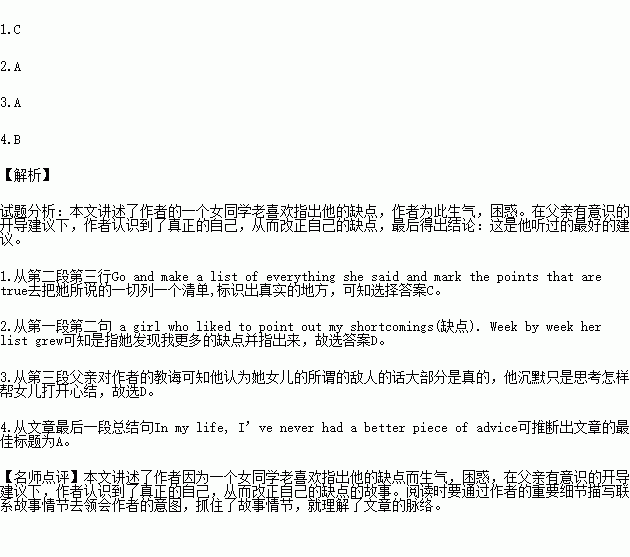题目内容
When I was about 12, I had an enemy, a girl who liked to point out my shortcomings(缺点). Wee k by week her list grew: I was very thin, I wasn’t a good student, I talked too much, I was too proud, and so on. I tried to hear all this as long as I could. At last, I became very angry. I ran to my father with tears in my eyes.
He listened to me quietly, then he asked. “Are the things she says true or not? Janet, didn’t you ever wonder what you’re really like ? Well, you now have that girl’s opinion. Go and make a list of everything she said and mark the points that are true. Pay no attention to the other things she said.”
I did as he told me. To my great surprise, I discovered that about half the things were true. Some of them I couldn’t change (like being very thin), but a good number I could—and suddenly I wanted to change. For the first time I go to fairly clear picture of myself.
I brought the list back to Daddy. He refused to take it.“That’s just for you,” he said.“You know better than anyone else the truth about yourself. But you have to learn to listen, not just close your ears in anger and feeling hurt. When something said about you is true, you’ll find it will be of help to you. Our world is full of people who think they know your duty. Don’t shut your ears. Listen to them all, but hear the truth and do what you know is the right thing to do.”
Daddy’s advice has returned to me at many important moments. In my life, I’ve never had a better piece of advice.
1.What did the father do after he had heard his daughter’s complaint?
A. He told her not to pay any attention to what her“enemy” had said.
B. He criticized (批评) her and told her to overcome her shortcomings.
C. He told her to write down all that her“enemy” had said about her and pay attention only to the things that were true.
D. He refused to take the list and have a look at it.
2. What does “Week by week her list grew” mean?
A. Week by week she discovered more shortcomings of mine and pointed them out to me.
B. She had made a list of my shortcomi ngs and she kept on adding new ones to it so that it was growing longer and longer.
C. I was having more and more shortcomings as time went on.
D. Week by week, my shortcomings grew more serious.
3. Why did her father listen to her quietly?
A. Because he believed that what her daughter’s “enemy” said was mostly true.
B. Because he had been so angry with his daughter’s shortcomings that he wanted to show this by keeping silent for a while.
C. Because he knew that his daughter would not listen to him at that moment.
D. Because he wasn’t quite sure which girl was telling the truth.
4. Which do you think would be the best title for this passage?
A. Not an Enemy, but the Best Friend
B. The Best Advice I’ve ever Had
C.My Father
D. My Childhood
 通城学典默写能手系列答案
通城学典默写能手系列答案书面表达
目前,许多学校对学生采取封闭式管理,学生对此看法不一。请根据下表所提供的信息,用英语写一篇100词左右的短文,客观地介绍讨论情况,并谈谈你的看法。
有的同学认为 | 有的同学认为 |
学校限制我们的自由;学生和社会接触少;学生的兴趣和爱好不能得到充分的 发展。…… | 学校是学习知识的地方:学生应该安心 在学校里学习;学生缺乏自觉性,离开了老师,可能会…… |
你的看法: | |
______________________________________________________________________________
_____________________________________________________________________________
______________________________________________________________________________
_____________________________________________________________________________
______________________________________________________________________________
______________________________________________________________________________

